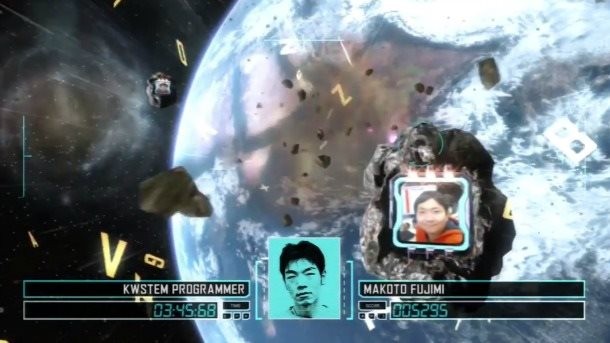Please support Game Informer. Print magazine subscriptions are less than $2 per issue
Where Credit Is Due – Video Game Credits That Innovate

You just conquered the last boss or finished off a trilogy. Besides your initial excitement and maybe an achievement or trophy, what is left? Most likely a plain, black screen scrolling through the names of hundreds of talented people. A standard credit scroll makes sense for movies, but it doesn’t make as much sense in video games. As games mature and embrace what makes them unique, credits need to evolve to reflect the interactivity that makes them special (while still giving proper recognition to creators). Here are lessons that the industry needs to learn about end-game credits from games that got it right.

Make The Credits An Extension Of The Game
|
Awesome Non-Interactive Credits Portal’s infamous Still Alive song also matches the game’s humor along with being a fitting – if temporary – send-off for the villain GLaDOS. Shadow of the Colossus uses the finality of credits as a way to force the player to reflect on what they’ve done. The slain colossi it scrolls through are reminders of the horrific deeds you’ve done throughout your journey. |
Devil May Cry 3 and 4 marry their gameplay to scrolling names in the most appropriate way. After a climactic final boss fight and short, calm ending cutscene, demons pour into an arena and the names start to scroll. Mixing combat and credits is both respectful to the hard-working team and perfectly emblematic of the game’s relentless action. Devil May Cry 3 and 4’s credits maintain the tempo of the rest of the game and take full advantage of the interactivity of the medium. Bayonetta replicates this formula, replacing hard rock with sexy jazz.
Katamari Damacy and Flower both directly channel their gameplay systems during the credits. Katamari Damacy lets the player roll up all the countries on Earth into a ball, while Flower strings together collectible petals to guide you from name to name. Using the game’s mechanics means the credits are essentially a short, bonus stage that entertains the player like any other normal level.
Directly interacting with the names is another possible avenue, which a few games have explored. Instead of only being serenaded by their delightful soundtracks, Rayman Origins and New Super Mario Bros. Wii let players treat the thousands of names like destructible platforms, free to be jumped on or butt-stomped. Super Smash Bros. for the Wii U also takes this approach by letting fighters directly combat the names as they speed by. Noby Noby Boy even lets players eat and poop out every letter of the credits. While very basic examples, they place their mechanics into the credits, albeit with no goal other than to goof around.

Turn The Credits Into A Mini-Game
Some games turn the credits into a different genre altogether. Vanquish and Super Smash Bros. Melee flip the script and turn the credits into an on-rails shooting mini-game where the targets are the names of the creative team. Tatsunoko vs. Capcom: Ultimate All-Stars turns the credits in an odd bike-riding mini-game where the player can jump around and collect golden letters to unlock a hidden shoot ‘em up mode. While gameplay consistency is noteworthy in titles like Devil May Cry 3 and Flower, these one-off mini-games work because of their interactivity in addition to their novelty. Surprising the player with something completely different from the main game is a good change of pace and an alternate way to add playability into the credits.

Think Outside The Box
|
More Awesome Non-Interactive Credits God Hand’s goofy credit sequence plays the corniest song with stiff background dancers that have the rhythm and coordination of most suburban dads. It’s stupid, memorable, funny, and catchy in the most endearing ways. The Legend of Zelda: Skyward Sword shows what Zelda was doing while Link was on his adventure in a series of dialogue-free cutscenes that play during the closing credits. |
This could be just the beginning. The aforementioned games have interacted with credits in some capacity, but games like Chrono Trigger, The Stanley Parable, and Ratchet and Clank explore possible avenues for the next step in interactive credits. After unlocking the most difficult ending, Chrono Trigger lets you walk around and chat with the pixelated representations of the development staff. Although not technically during the credits, Stanley Parable and some of the Ratchet and Clank games allow you to wander around a museum and check out fragments of the game during its development along with cut content and explanations from the team.
Both approaches sow seeds of interacting with the developers directly and seeing how games are made and who did what. Imagine walking around a virtual Naughty Dog as Joel in The Last of Us and going into different sections of the office to meet the staff and hear about or see what their involvement was. It’s a little like what Doom did during its fantastic credits by juxtaposing individual names next to stills of what they worked on, albeit more interactive. This process is exponentially more involved but fully exercises the unique strengths of games.
Lacking an inventive or interactive credits sequence doesn’t automatically mean a game isn’t creative or fun. There are classic games with boring credit sequences like Bioshock and not-so-classic games with excellent credit sequences like Double Dragon: Neon, which features the game’s antagonist falling to his death and singing for the duration of the scroll. But it’s time for more games to use the defining aspects of the medium for something as universal as credits. It’s the part of the game that pays respect to its creators so it deserves more attention.










